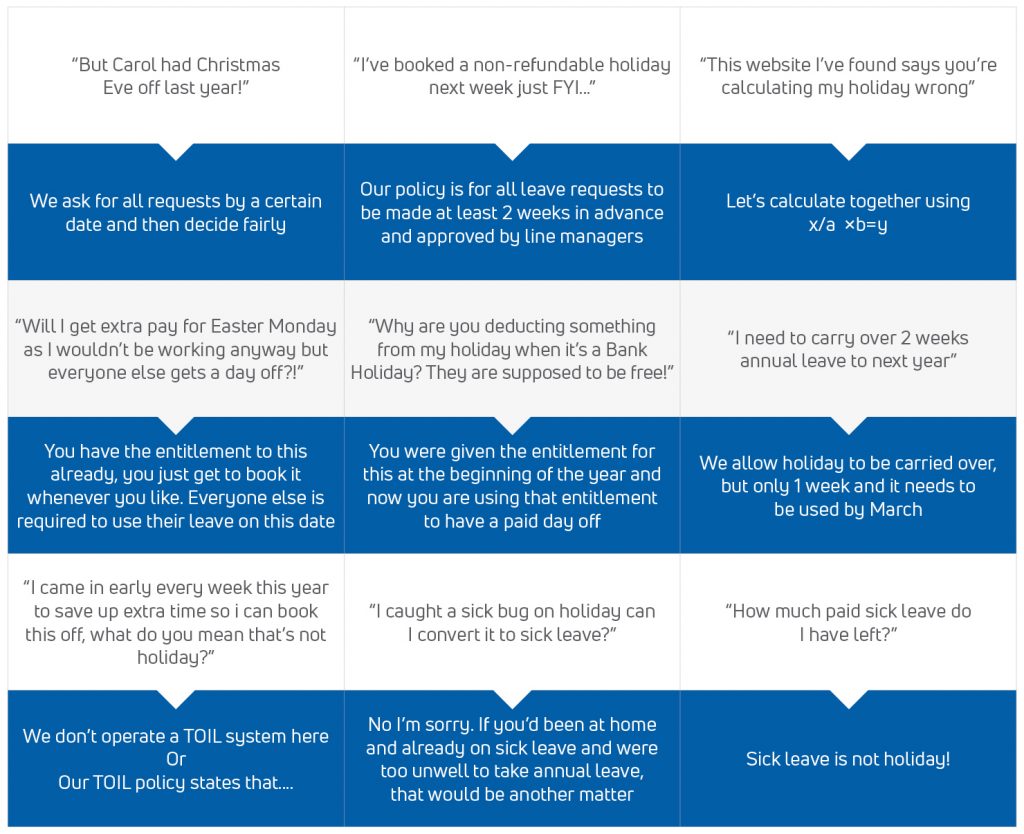Having time off work is great! Isn’t it? Well, yes, unless you’re the poor PM stuck organising it all!
There’s so much that goes into arranging time off, and so many categories. Sick leave, annual leave and bank holidays, study leave, maternity/paternity/adoption leave… The list goes on and on.
The biggest headache comes in the form of annual leave. It’s complicated but it’s the same story wherever you go. The tricky areas are so common you could play bingo with them – how many of these can you cross off?!
So, here’s a breakdown of the most contentious issues around annual leave, what the law says, and some helpful tips and tricks from us:
TOIL (Time Off In Lieu)
The term “TOIL” has been around a long time, and your surgery may or may not offer a TOIL scheme. The tricky area is where there has never been a formal TOIL process, but some sub-groups have adopted a flexible, friendly system anyway. This can be absolutely fine, until suddenly it isn’t… and of course then it lands on your desk! So, it’s important to either have a formal TOIL system in place, and ensure it is fair and offered to all staff, or to draw a line and formalise that there is no TOIL system in place (and simply pay overtime for any pre-approved overtime). There are pros and cons to TOIL.
PROS
- Saves money – if someone can give you an extra hour when you’re really busy and have that time back when it’s quiet – brilliant! You’ve met the demands of your business at no extra cost
- The employee feels valued – a feeling of flexibility and instant reward for extra work is a good morale booster
- In smaller teams, it can promote teamwork – Sarah covers Allan on Monday, and the following Friday, Allan covers Sarah – great for a sense of all muddling in together and helping each other out
CONS
- Staff can hoard TOIL – when a system like this is in place and the teams feel empowered to use it, you can often find people holding on to TOIL, accruing it on purpose, creating a sort of second-holiday-pot. This can be hard to manage. You think you’ve got the rotas and calendars all in order, then Raymond pipes up with, “Yeah but I’m having that week off, you know, with my TOIL?”
- It can backfire – in the example above (where someone can give you an extra hour when you’re really busy and have that time back when it’s quiet), the assumption is that the time will be taken back at a time that is suitable to the business. In reality, most people want the time back when it suits them… and that might not be at a great time. That then leaves you having to ask a different person to do the extra… and you’re going round in circles (and who’s got time for that?!)
So, what can you do?
First, decide if TOIL is going to be a thing or not. Consider the workload involved in organising it and make sure you have capacity to manage it. If you decide to go for it, make sure the parameters you set are right for the teams and the business, and make them crystal clear (a policy would be best, and a signed one even better!). Then make sure you keep really good records of the TOIL (we have an amazing toolkit to help stay on top of everyone’s TOIL).
Top tip – Put in place a “Use it or lose* it” policy to encourage TOIL to be taken back within the same working month – to avoid stockpiling. (*Have it converted to paid overtime if it’s not taken back in time). Also make sure it’s all “pre-authorised” extra time. You don’t want employees working extra when it suits them (the bus was early, they’re waiting for a lift, “it all adds up,” etc.) and then holding you to account for the time off later.
Links: Time off in lieu and overtime policy [PLUS] TOIL toolkit [PLUS]
Calculating annual leave entitlements
Making sure entitlements are dished out fairly is a huge bone of contention for many PMs. It’s a regular feature on our forums. You’ve got staff on different contracts with different basic entitlements. Then you have staff leaving part-way through the year who will have a reduced entitlement and some usage, and will have used either too much or too little. Then you have new staff starting part-way through the year who will have reduced entitlement. And then you’ve got an array of part-time and full-time staff on wildly different working patterns… So how does it all work?
The basics
Okay, so before we account for any kind of pro-rata (for part-year or part-time) let’s remind ourselves what annual leave entitlements actually are for a full-timer. Legally, all employees are entitled to an absolute bare minimum of 28 days leave (or 5.6 weeks). Critically, this “may include bank holidays”, so employers will tend to interpret that to mean 20 days are annual leave and the 8 standard bank holidays account for the remaining days. They aren’t actually separate entitlements, but you must make sure all 28 days are included in their basic full-time equivalent entitlements.
Pro-rata
When you come to pro-rata entitlements, it’s important to pro-rata the entire entitlement including bank holidays (they aren’t a separate ring-fenced entitlement).
Part-time workers
Part-time workers will be entitled to a percentage of the full-time entitlement. So if full-time is 40 hours and you have someone working 20 hours a week, their entitlements will be half that of a full-time worker. To calculate pro-rata leave, use the calculation below (this is all in hours):
a = Full-time weekly hours
b = Part-time weekly hours
x = FTE entitlements
y = Pro-rata entitlements
(We also have a toolkit that calculates this for you.)
Starters, leavers, and both!
So someone starts part-way, leaves part-way, or does both! The calculation you need for that is the same, just with different components:
a = Weeks in the holiday year
b = Weeks the employee was employed
x = Employee entitlements (might already be pro-rated using the calculation above if part-time!)
y = Pro-rata entitlements
Top tip – Always calculate holiday in hours if you can. A fraction of a day is not easy to understand, especially when a “day” is longer on a Tuesday than a Friday for someone. The safest way to manage all of this is in hours!
Links: New starter holiday calculation tool [PLUS], Leavers holiday calculation tool [PLUS]
Bank holidays
We mentioned bank holidays above, and we know that a full-time worker is entitled to annual leave and that the employer will determine how much leave is on offer, ensuring that it does not dip below 28 days in total (including bank holidays, unless the employer chooses to be generous). So that’s the entitlement sorted. But real life is, of course, different…
The background to the problem with bank holidays is the deep-rooted misconception that one is entitled to have the day off because that day is a bank holiday. Sadly, that is simply not true.
As far as “rights” go, the only right relating to a bank holiday is to have 5.6 weeks given to you as paid time off (which we covered in the entitlements section). As long as someone’s entitlement to leave is not below that full-time equivalent, there is no automatic right to have a bank holiday off (unless your employment contract says something to this effect).
What tends to happen is that the organisation is closed for the bank holiday, meaning anyone who would have been working takes the day off and is paid. So it’s more like mandatory paid leave.
Calling it mandatory paid leave would make it much easier to explain!
Critically, when someone’s leave entitlement is pro-rated, the bank holiday portion of that entitlement is not ring-fenced or treated differently, it ALL gets apportioned. So, depending on work patterns, this mandatory paid leave might affect them heavily, meaning a lot of their leave is taken up by mandatory days and there is less available for personal choice.
Top tip – Another way to explain this to part-time people who feel aggrieved that they’ve lost lots of their available leave to bank holidays, or to those people who feel they are missing out on something when a bank holiday lands on a day they wouldn’t be working anyway, is to convert it all to the concept of money. The 28 days might be, say, £28. So each time you take a day off, we give you £1 from your pot of £28.
Katie and Cat both work full-time.
Cat works all her hours Tuesday to Friday (having Mondays off).
Katie works her full-time hours Monday to Thursday.
On Monday 3rd January this year, Cat and Katie were both at home. Neither came to work. For Cat, it’s not usually a working day for her, so we don’t take £1 out of her pot and give it to her. She gets nothing from her pot and loses nothing from her pot. Katie would have been at work, but couldn’t be because the surgery was closed, so we give her £1. Now Katie’s been given £1, Cat’s been given nothing…. But Katie only has £27 left and Cat still has £28.
Crucially, both started with £28 and will have spent £28 at the end of the year, regardless of how the bank holidays, or mandatory paid leave, have played out in real-time.
Links: Bank holidays: the ultimate guide, FLEXI bank holiday calculator [PLUS] [PLUS]
Managing holiday requests and bookings
So you’ve got everyone’s entitlements right, everyone understands bank holidays, TOIL is dealt with… Now, how do you manage it all?! You need a system. It’s all too easy for a chat in the kitchen to become a holiday request, or a quick, “Oh and can I have next Tuesday off?” to be tagged on to the bottom of an email (or worse still, a text on a Sunday morning!). We’ve all been there.
So, create a policy and stick to it. Need two weeks’ notice as a minimum? Make it policy and stick to it. Need holiday to be approved by a line manager? Make it policy. Make a form, or a designated email address, or some other process. Pick a date, and launch the new process. (We have toolkits for this too!)
Your policy needs to address carrying over holiday. Some companies allow it, some don’t, some have a cap or a use-by-date. Whatever you choose to do, make sure it’s written as a policy and read/understood by all, and stick to it.
Links: Holiday and sickness planner [PLUS], Holiday Policy [PLUS]
Managing peak seasons fairly
Christmas, summer holidays and half terms can be particularly difficult. Most surgeries are made up of sub-teams (admin, reception, nurses…etc.), so within the mix there’s generally scope for working together to ensure no one person is swiping all the best bits of the year. In larger teams, or more complicated structures, this may be more difficult to manage informally. Therefore, it’s important to have a system and protocol that everyone understands.
Let’s take Christmas as the perfect example. Almost everyone would like some time off over Christmas. This year we had three working days in the middle of all the bank holidays and weekends. Prime real-estate for the astute holiday booker… How many of you felt the pressure when all the requests came tumbling in (last January!). The fairest approach is a model I adopted several years ago and have used ever since:
Step 1 – Create a “Christmas holiday booking time window”. For me, that was 1st September to 31st October.
Step 2 – Announce that requests for time off over Christmas may be submitted within the booking time window.
Step 3 – Any requests for leave over the Christmas period (let’s say 18th December to 4th January as an example) are automatically declined before 1st September.
Step 4 – Announce the booking window open (and receive lots of requests which are all put aside while the window is open).
Step 5 – Announce the booking window closed.
Step 6 – Review all the requests. Consider factors such as previous Christmases, who is new, who had lots of time off at other peak times like summer or Easter, and crucially, who you had to decline in the past for this and other peak times due to colleagues already being booked off. Decide what is fair. Book that in and confirm back to everyone what leave they’ve been allocated.
Step 7 – Go to the pub and order a large glass of Malbec and a bowl of chips (and one for me please!).
Other absences
Sometimes absences collide. Here’s a simple guide to how those can interact:
Sickness and holiday: If someone is off sick when they were due to be on holiday, they can request that the time is converted to sickness absence and the holiday added back to their entitlement. This doesn’t mean someone on holiday can just call up and say they are sick so the holiday goes back in their pot. They must follow the usual sickness reporting procedures and produce a medical certificate to cover their absence if it is more than seven days, or for any period if the organisation’s policy requires it. This applies even if the employee is abroad.
Maternity/Paternity/Adoption: While on this type of leave, bank holidays will not be considered as having been taken. Instead, they will remain part of the employee’s entitlements and can be taken after the employee’s return from the leave period.
Links: Sickness with Bradford factor toolkit [PLUS], Maternity Pay Calculator [PLUS], Maternity Leave and Pay Policy and Procedure [PLUS], Adoption Leave and Pay Policy and Procedure [PLUS], Paternity Leave and Pay Policy and Procedure [PLUS]
In summary
So let’s come back to our bingo board and see if we can now give better answers:
Useful resource: Holiday Policy [PLUS]








January 21, 2022 at 9:46 am
Just working on this at the minute. Sorting out summer leave. Even have requests for next Christmas! We usually get it sorted by getting all the team together. Once someone who has the same week off every year is actually face to face with the person eg whose daughter is getting married that week, they usually are willing to change. But the large glass of Malbec and chips gave me a laugh – that should be on expenses!!!